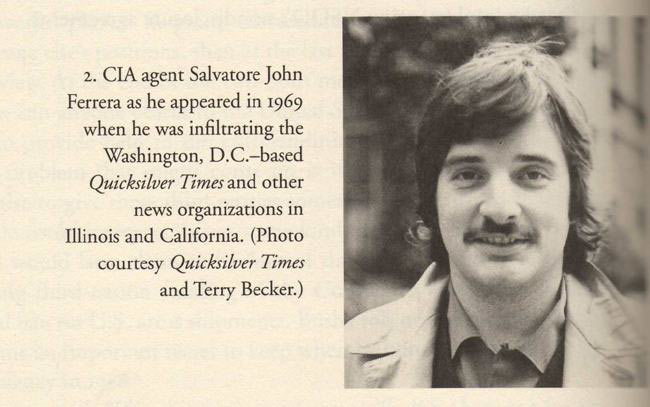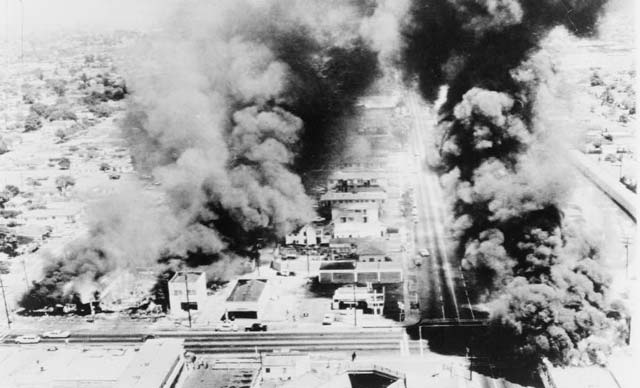
Fifty years ago, during the hot, dry days of early August, the city of Los Angeles erupted in flames in a weeklong riot leaving dozens dead, more than 3,000 arrested and $40 million in property damage. This landmark event came to be known as the Watts rebellion of 1965. This year also marks 40 years since the revelations of the Senate committee and Rockefeller Commission investigations of US intelligence covert activity against US dissidents throughout the 1960s and early 1970s. Both legendary events and their interrelationship have something important to teach us about the growth of the national security state (NSS) and the criminalization of US dissent.
The NSS refers to a set of principles and strategies to ensure political and economic hegemony over other potential political or economic rivals within the modern world system and aims to neutralize potential threats to this hegemony (both within the hegemonic state itself and within the larger world system). The NSS also refers to a set of institutions dedicated to “national security” such as the Central Intelligence Agency (CIA), Defense Intelligence Agency (DIA), Federal Bureau of Investigation (FBI) and the Pentagon, among others. It also importantly refers to the institutional spread of the logic of “national security” to other seemingly apolitical institutions like the IRS, Health and Human Service (HSS) and the media.
The campus where I teach, California State University, Dominguez Hills, is a product of the 1965 Los Angeles uprising. Our campus was slated to be a “Harvard of the West.” Originally, it was to be constructed in the nearby wealthy community of Palos Verdes. Watts changed all that. One of the outcomes of the rebellion was the decision to relocate Dominguez Hills to serve the Black community of South Central Los Angeles, Compton and surrounding areas. This was one of the state’s modest concessions to the Black community. These concessions also included passing the Rumford Fair Housing Act of 1966, an acknowledgement of the historic deprivation and oppression suffered by the Black community. By the end of 1965, the McCone Commission released a report concluding that the social conditions of the Black community (unemployment, discrimination in housing and police abuse) were the triggers of the social explosion in Watts. In 1967, President Lyndon Johnson convened the Kerner Commission to study the origins of urban riots. The final commission report concluded that both white racism and lack of economic opportunity for Blacks were key causes of urban unrest.
The Watts rebellion was a major turning point for the civil rights movement as increasing numbers of Black activists began to position their fight for human rights alongside the global struggle against colonialism.
Choosing to ignore the findings of both reports, Johnson helped to usher in another set of extremely important yet largely unacknowledged consequences of the Watts rebellion. The Watts uprisings and those that followed in numerous US cities were a key factor in the development of covert counterintelligence/counterinsurgency programs launched against US dissidents by the US government. The existence of these programs was officially recognized in 1975 when President Gerald Ford set up the Rockefeller Commission to investigate abuses committed by the CIA and other intelligence agencies after revelations of such wrongdoing began to appear in the media. This was followed by the Senate committee investigations, headed by Sen. Frank Church, which also revealed the existence of covert programs that violated the rights of Americans.
Several factors led to the formation of the government investigations of US intelligence activities. These included Seymour Hersh’s 1974 New York Times article on a massive CIA spying program on US dissidents (Hersh 1974), the burglary of FBI documents in 1971 by activists that exposed the existence of the FBI’s Cointelpro (Medsger 2014), and the ongoing news of the Watergate scandal. Though the Senate committee and Rockefeller Commission reports barely scratched the surface of the illegal activities committed by US intelligence agencies, the exposures of these programs (behavior modification and mind control programs, assassination attempts of foreign leaders, unethical human experimentation and far reaching domestic surveillance and disruption programs such as the FBI’s Cointelpro and the CIA’s Operation Chaos) caused outrage among the US public.
The Senate committee report states that President Johnson’s assistant referred to the effects of the Watts uprising as “shattering” (1976, 99). The Watts rebellion terrified the national security establishment. The Los Angeles Police Department was wholly unprepared to deal with such a wide-scale social uprising. Something had to be done. The moment the ink was dry on the McCone and Kerner Commission reports and as the last embers flickered into ash in Los Angeles, the various agencies comprising the national security state swung into action. Suddenly, the focus shifted from the social roots of the rebellion discussed in the McCone and Kerner reports to a “lack of coordinated intelligence” among US intelligence agencies, claiming a dire need to “predict” and “prevent” future unrest in the Black community (US Senate 1976, 99). Also critical to the development of these programs was Johnson’s directive to uncover any communist or foreign ties to Black, student and antiwar activism.
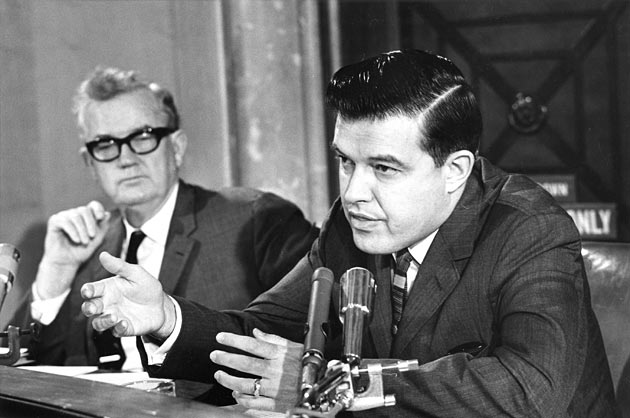 The Venerable Sen. Frank Church. Photograph courtesy the Frank Church Papers, Special Collections and Archives, Boise State University.
The Venerable Sen. Frank Church. Photograph courtesy the Frank Church Papers, Special Collections and Archives, Boise State University.
The Watts rebellion was a major turning point for the civil rights movement as increasing numbers of Black activists began to position their fight for human rights alongside the global struggle against colonialism. The Black Panther Party (BPP) was born in Oakland in 1966 and was the movement that most clearly articulated the anti-colonial orientation of the Black freedom struggle. This dovetailed with the rapid escalation of the Vietnam War and the equally rapid rise in opposition to that war.
It is estimated that one out of every five or six Communist Party USA members and one out of 10 Socialist Workers Party members were FBI informants.
Since taking over Vietnam from the French in 1954, the US government faced an implacable and elusive enemy. Unable to fathom the true roots of the Vietnamese resistance to US occupation, the US military developed several different counterinsurgency campaigns. As these campaigns failed to quell the growing civil resistance, Washington war makers understood that without defeating the political and civil resistance to the South Vietnamese government and the US military, the war would never be won. In order to secure a military victory, the political opposition had to be neutralized. This meant that the political infrastructure of the Vietcong (VCI) needed to be dismantled.
With this goal in mind, in 1967, previous counterinsurgency campaigns directed by various branches of the US military, the CIA and the US Agency for International Development (USAID) were woven into one overarching counterinsurgency project, a CIA directed and coordinated “Phoenix program” (Valentine 2000). The Phoenix program drew together the Province Interrogation Centers (PIC), the Census Grievance program, the Provincial Reconnaissance Units, among others, in order to control the political environment of the Vietnamese people. Also key to Phoenix was the use of personnel from almost every branch of the military and USAID, among other supposedly more “diplomatic” agencies concerned with the civic and cultural aspects of Vietnamese society. The multiple strategies of Phoenix pacification included collecting intelligence gathered in statistical form, creating blacklists, conducting targeted assassinations, using selected terror against Vietnamese civilians, indefinite detention of VCI suspects and the use of torture. The widespread use of informants, blacklists, selective terror and black propaganda defined the Phoenix program all the while mirroring itself in its twisted sister and US-based counterpart, MH Chaos or Operation Chaos.
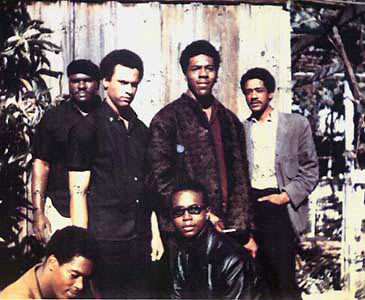 Original six Black Panthers (November 1966). Top left to right: Elbert “Big Man” Howard, Huey P. Newton (defense minister), Sherman Forte, Bobby Seale (chairman). Bottom: Reggie Forte and Little Bobby Hutton (treasurer). (Photo: Marxists.org)Operation Chaos was developed in 1967, under CIA director Richard Helms and Richard Ober, head of the Special Operations Group (CI/SOG) in the CIA’s counterintelligence branch. One motivating factor for the development of Chaos was the revelations of CIA funding and control of the National Student Association (NSA) that appeared in Ramparts magazine in 1967, and a 1966 Ramparts story about how the CIA used the University of Michigan as a cover to train Vietnamese police. Stanley K. Sheinbaum, who had unwittingly worked for the CIA as a University of Michigan professor, coauthored the 1966 Ramparts article with Robert Scheer. This sent the CIA on the warpath against Ramparts. Leaks were becoming a huge problem and MH Chaos was organized to prevent any future leaks about CIA operations. The other purpose of Chaos was to coordinate counterintelligence and covert action projects of the FBI, IRS, all branches of the US Armed Forces, and major metropolitan police departments’ intelligence units into one clearinghouse for data on the political activity of Americans.
Original six Black Panthers (November 1966). Top left to right: Elbert “Big Man” Howard, Huey P. Newton (defense minister), Sherman Forte, Bobby Seale (chairman). Bottom: Reggie Forte and Little Bobby Hutton (treasurer). (Photo: Marxists.org)Operation Chaos was developed in 1967, under CIA director Richard Helms and Richard Ober, head of the Special Operations Group (CI/SOG) in the CIA’s counterintelligence branch. One motivating factor for the development of Chaos was the revelations of CIA funding and control of the National Student Association (NSA) that appeared in Ramparts magazine in 1967, and a 1966 Ramparts story about how the CIA used the University of Michigan as a cover to train Vietnamese police. Stanley K. Sheinbaum, who had unwittingly worked for the CIA as a University of Michigan professor, coauthored the 1966 Ramparts article with Robert Scheer. This sent the CIA on the warpath against Ramparts. Leaks were becoming a huge problem and MH Chaos was organized to prevent any future leaks about CIA operations. The other purpose of Chaos was to coordinate counterintelligence and covert action projects of the FBI, IRS, all branches of the US Armed Forces, and major metropolitan police departments’ intelligence units into one clearinghouse for data on the political activity of Americans.
Just as the Phoenix program was deemed necessary because of the failure to “neutralize” civilian support for the Vietcong, Chaos grew out of the failure of the FBI’s Cointelpro and the CIA’s other domestic programs run out of their Office of Security, Project Merrimac and Resistance to neutralize growing domestic dissent. Prior to Chaos, the CIA’s Merrimac and Resistance programs had infiltrated groups such as Women Strike for Peace (WSP), Student Nonviolent Coordinating Committee (SNCC), Congress on Racial Equality (CORE), and Students for a Democratic Society (SDS), among others, ostensibly to prevent attacks on CIA personnel or installations. Cointelpro was launched by J. Edgar Hoover in 1956 primarily against the Communist Party USA (CP USA) and then in 1961 against the Socialist Workers Party (SWP).
The fact that the Interdivisional Information Unit was managed by senior White House staff reflects its concern with “politics” rather than “foreign control of dissent” or even “internal security.”
In 1967, Cointelpro launched a campaign against the Black Panther Party. It is estimated that one out of every five or six CP USA members and one out of 10 SWP members were FBI informants. Richard Helms preciously guarded the secret existence of Chaos through the compartmentalization of the program, deliberately keeping the Chaos program hidden from other divisions of the CIA and through a special communications system that bypassed normal CIA communication channels (Valentine 2001). Chaos also contained a computerized index of US dissidents called Hydra located in a soundproof basement in Langley, Virginia. By the end of the Chaos program in 1974, the lists of names in the database reached 300,000. In 1967, under President Johnson, the Interdivisional Information Unit (IDIU) was created in the Justice Department by Ramsey Clark to coordinate Cointelpro and Chaos operations. As Doug Valentine points out, the fact that the IDIU was managed by senior White House staff reflects its concern with “politics” rather than “foreign control of dissent” or even “internal security.”
Under President Nixon, demands on the Chaos program intensified through a secret White House plan called the Huston Plan and then the highly secretive “Intelligence Evaluation Committee” (IEC). Either Richard Ober or Richard Helms sat on virtual every White House committee formed to deal with dissent and social conflict in the United States, including the National Commission on the Causes and Prevention of Violence and the Law Enforcement Assistance Administration (LEAA), which through block grants provided training for local police in the art of riot control, counterinsurgency training and funding for criminology research on the social aspects of crime. The LEAA also included funding for behavior modification research and programs in veterans’ hospitals and prisons.
The targets of the Chaos program were similar to Merrimac and Resistance (Women Strike for Peace (WSP), the Black Panther Party (BPP), Revolutionary Action Movement (RAM), Student Nonviolent Coordinating Committee (SNCC), Students for a Democratic Society (SDS), Army deserters, and importantly, the underground antiwar press).
The official rationale for the Chaos program was to detect “foreign influence” on the US peace, student and Black liberation movements. Defenders of Chaos claim that the program was to find out if foreign agents were controlling or funding US dissidents (Rafalko 2011). They argue that Chaos agents were gathering intelligence on Americans only inadvertently and minimally and that any intelligence gathered was only incidental (though admittedly this intelligence was always passed to the FBI). One key part of the program was a project that included 40 agents recruited and “sheep dipped” in the antiwar, student and Black power movements. “Sheep-dipping” can refer to either the process by which a soldier’s military records can be changed to cover up covert activities or it can refer to placing an agent in a radical political organization so that, over time, the agent can develop “radical credentials.” In this case, “sheep-dipping” can be referred to as “reddening.” Once sheep-dipped and sufficiently reddened, these agents could be deployed abroad and be used as “dangles” to flip agents of foreign governments, turning them into double agents (especially in countries like Cuba, Algeria and Vietnam).
Documents released from the Helms lawsuit reveal that nearly half of the Chaos program was devoted to “Black Militants” in general and the Black Panther Party in particular.
Helms states that 40 agents were recruited both unilaterally (directly recruited by the CIA) and bilaterally (through the use of FBI assets). The Rockefeller Commission report concluded that this aspect of Chaos was a “legitimate counter intelligence function” because of its focus on the foreign involvement with US dissidents. However, as will be discussed later, declassified Chaos documents from a lawsuit filed by WSP (and a host of other organizations and individuals) against Helms in 1976 revealed that the Rockefeller Commission and Senate committee reports were misleading in several aspects. For example, both reports gave the impression that almost all of the resources of Chaos were devoted to the antiwar movement (For example, just look at the title of the Seymour Hersh article). However, documents released from the Helms lawsuit, Halkin v. Helms (1976), reveal that nearly half of the Chaos program was devoted to “Black Militants” in general and the Black Panther Party in particular (CNNS C-34, Box 6).
Chaos not only devoted a significant amount of resources to the Black liberation movement, but to the underground antiwar press as well. This important fact is very much downplayed in both the Senate committee and Rockefeller Commission reports. Angus Mackenzie’s posthumously published account of the Chaos program and its legacy definitively demonstrates the “domestic” nature of MH Chaos. Mackenzie’s research found that at least one CIA agent infiltrated the 1971 May Day Mobilization Committee. That CIA operative was Sal Ferrera. This agent also insinuated himself into antiwar underground publications such as the Quicksilver Times. As with the CIA’s consternation with Ramparts, the CIA’s war against the underground antiwar press in general had to do with controlling access to information and leaks, and I would argue, the control of ideas, not foreign influence. Again, it makes perfect sense that the CIA and those who seek to protect the agency would downplay CIA infiltration of grassroots media. It contradicts the conclusions of the Rockefeller Commission.
Ferrera’s case shows that MH Chaos was not an objective intelligence gathering operation with the goal of proving or disproving foreign control of domestic dissent. Rather it was designed to control the flow of information about the “sensitive” (read: illegal) CIA operations. It was a campaign of active disruption and neutralization that took many forms. As Mackenzie states:
The importance of Ferrera’s excellent intelligence work cannot be overestimated. It was espionage with a political bent, and it was relayed directly from the CIA. By this point in his administration Richard Nixon was extremely defensive about protests. With Ferrera’s reports, local police and federal officials would be able to find a means of containment (1997:38).
Here, we have CIA intelligence work in the service of containing US protest. This points to the Chaos program having broader involvement with the management of US dissent.
Ferrera was also put on assignment to befriend Philip Agee, a CIA whistleblower living in Paris and writing the most explosive book that had been written about the CIA. After befriending Agee, Ferrera switched Agee’s typewriter with one that was bugged. Agee managed to publish his 1975 book, Inside the Company, without deletions and with a list of scores of organizations that were controlled by the CIA.
What were the true objectives of Operation Chaos and what do those objectives tell us about the nature of the national security state’s relationship with the US public?
 Frank Church. (Photo: US Congress)Sen. Gary Hart, one of the most aggressive investigators of the Senate committee, lamented that the committee had little interest in investigating the whole range of abuses that were committed against the American people by the intelligence community. He also states that the vast majority of the 600-page report compiled from CIA Director William Colby’s testimony that constituted the “family jewels” never made it into the final Church Committee report and never saw the light of day (Pease 2005).
Frank Church. (Photo: US Congress)Sen. Gary Hart, one of the most aggressive investigators of the Senate committee, lamented that the committee had little interest in investigating the whole range of abuses that were committed against the American people by the intelligence community. He also states that the vast majority of the 600-page report compiled from CIA Director William Colby’s testimony that constituted the “family jewels” never made it into the final Church Committee report and never saw the light of day (Pease 2005).
MH Chaos: A Necessary and Timely Excavation
By the time the Senate committee and Rockefeller Commission reports were released to the US public in 1976, an enormous amount of damage had been done to US democracy. The infiltration and disruption of the Black Panther Party alone resulted in thousands of false arrests, dozens of assassinations of BPP leadership and hundreds of false imprisonments. The US government currently has many political prisoners serving time based on frame-ups. In April 2014, Marshall “Eddie” Conway, founding member of the Baltimore BPP, was released after serving 44 years for the murder of a police officer, which he did not commit.
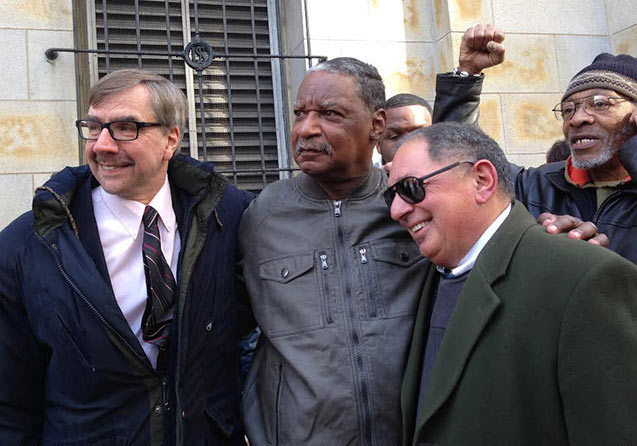 Marshall “Eddie” Conway, founding member of the Baltimore BPP, was released from prison in April 2014 after serving 44 years, having been falsely convicted of killing a Baltimore police officer in 1970 (with his lawyers Robert Boyle and Phil Dantes). (Photo: Laura Whitehorm)
Marshall “Eddie” Conway, founding member of the Baltimore BPP, was released from prison in April 2014 after serving 44 years, having been falsely convicted of killing a Baltimore police officer in 1970 (with his lawyers Robert Boyle and Phil Dantes). (Photo: Laura Whitehorm)
The infiltration and disruption of the Black Panther Party alone resulted in thousands of false arrests, dozens of assassinations of BPP leadership and hundreds of false imprisonments.
As Senator Hart of the Senate committee stated, the committee report failed to demonstrate the depth and breadth of the illegal activities of the FBI, CIA and other government agencies. The Halkin documents point to MH Chaos having a much larger focus on domestic dissent than had been previously understood. The Halkin documents reveal the CIA’s penetration of Women Strike for Peace since 1962 (only months after they were founded). The documents also reveal the “reddening” of agents placed in or recruited from Students for a Democratic Society for assignments abroad (CNSS C-34 Box 7).
In a review of a forthcoming book about the CIA’s infiltration of the National Student Association (NSA), Tom Hayden discusses the individuals he met through the NSA that were later found to be longtime CIA agents. He discusses Gloria Steinem’s work for the CIA as an organizer for a US anti-communist student delegation to the Soviet-sponsored Helinski Youth Festival in 1962. Hayden rightly points out that this history should be reflected upon today because:
The story begins in the 1950s, which may leave some to wonder if it’s not a stale and useless tale by now. It’s relevant today, however, because of the cancerous growth of Big Brother surveillance and the proliferation of clandestine operations branded in the name of “democracy promotion,” from Cuba to the Ukraine. The pervasive rise of secret money in campaigns, moreover, makes it impossible to know whether operatives of our intelligence agencies have any role in harassing radicals or steering social movements, or whether such roles have been passed to private foundations. Democracy is increasingly in the dark. Any light from history can serve as high-beams to illuminate the future (Hayden 2014).
Hayden’s call to reflect on the history of the infiltration (not just spying) and disruption of domestic movements by US intelligence programs like MH Chaos is timely and critical. 2014 has witnessed a resurgence of grassroots activism against police violence against primarily (though not exclusively) Black Americans. Young people are challenging the entrenched racist violence of law enforcement. Some of the roots of that violence stem from the state reaction to the rebellions of the 1960s, and were engineered through programs like MH Chaos and the Law Enforcement Assistance Administration. Most importantly, we need to understand that we never were told the full extent of abuses committed against Americans. We must know the whole truth.
References:
Center for National Security Studies. C-34 Chaos Merrimac Resistance collection Box 6 and 7 National Security Archive.
Hayden, Tom. 2014. “The CIA’s Student Activism Phase.” The Nation. November 26. https://www.thenation.com/article/191569/cias-student-activism-phase#
Hersh, Seymour. 1974. “Huge C.I.A. Operation Against Antiwar Forces and Other Dissidents in Nixon Years.” The New York Times. December 22. Pp. 26.
Mackenzie, Angus. 1997. Secrets: The CIA’s War at Home. Berkeley, CA: University of California Press.
Medsger, Betty. 2014. The Burglary: The Discovery of J. Edgar Hoover’s Secret FBI. New York, NY: Knopf.
Pease, Lisa. 2005. “The Enduring JFK Mystery.” Consortiumnews.com November 22.
Rafalko. Frank. 2011. MH/Chaos the CIA’s Campaign Against the Radical New Left and the Black Panther Party. Annapolis, MD: U.S. Naval Institute Press.
Rockefeller Commission. Report to the President by the Commission on CIA Activities Within the United States, June 1975.
US Senate. Final Report of the Select Committee to Study Government Operations with Respect to Intelligence Activities, United States Senate, (94th Congress, Second Session, Report No. 94-755) (Government Printing office; April 23, 1976
Valentine, Douglas. 2000. The Phoenix Program. iUniverse: Lincoln, NE
Valentine, Douglas. 2001. “Chaos and Political Terrorism in America” Counterpunch
Join us in defending the truth before it’s too late
The future of independent journalism is uncertain, and the consequences of losing it are too grave to ignore. To ensure Truthout remains safe, strong, and free, we need to raise $47,000 in the next 8 days. Every dollar raised goes directly toward the costs of producing news you can trust.
Please give what you can — because by supporting us with a tax-deductible donation, you’re not just preserving a source of news, you’re helping to safeguard what’s left of our democracy.
